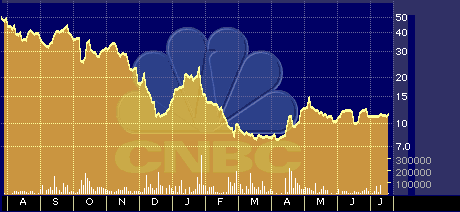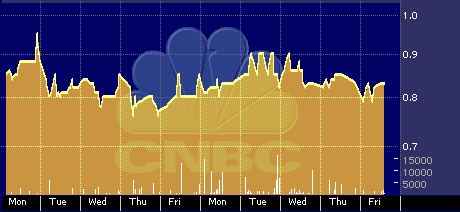
Inforte IPO Rockets Higher in Debut
Inforte IPO Rockets Higher in Debut
by Hal Plotkin
Silicon Valley Correspondent
Inforte Corp.’s {INFT} initial public offering is already being met with the same enthusiasm that lifted Lante Corp.’s {LNTE} IPO to a nearly 200 percent first-day gain last week.
“Inforte is in the same league as Lante,” says Stephanie Moore, research director at the Giga Information Group, based in Norwalk, Conn. “What makes them different from some of the newer companies I see is that they actually have profits.”

Inforte Post-IPO Stock-Performance Chart
The company priced its 2 million share offering Friday at 32 a share, above its most-recent range of 30 to 32, above an original range of 23 to 25.
Lante, which calls itself an Internet professional-services firm, went public last Friday with shares priced at 20. The stock shot up as high as 60 before settling back to the low 50s in early trading Monday. The company posted net income of $28,000 on revenue of $21.3 million for the nine months ended Sept. 30.

Lante Post-IPO Stock-Performance Chart
E-business integrator Inforte, based in Chicago, posted net income of $1.5 million on revenue of $20.5 million for the nine months ended Sept. 30. The prior year, fiscal 1998, Inforte generated net profits of $770,000 on revenue of $13.4 million. Revenue was up 109 percent and net income up 187 percent, from the end of September 1998 to the end of September 1999.
Profits aside, another thing that makes Inforte unique among newly public Internet firms is a marketing approach that emphasizes a stable of satisfied customers. Inforte’s marketing materials claim that all 120 corporate customers served by the firm over its entire seven-year history are available to give positive references about their experiences. Customers on that list include CompUSA {CPU}, Intuit Inc. {INTU}, R.R. Donnelley & Sons Co. {DNY} and Sun Microsystems Inc. {SUNW}.
Analysts say Inforte generates those raves by getting the job done for its clients, often on a fixed-price basis, and by being willing to occasionally lose money on some contracts if actual costs exceed the company’s original bid.
“Clients of many other firms are telling some real horror stories about a lack of follow-through,” says Christine Overby, an associate analyst at Forrester Research, based in Cambridge, Mass. “Inforte’s approach is hugely important in this market right now. It builds confidence.”
Much hinges on Inforte’s successful track record. The company’s S-1, its official pre-IPO filing with the Securities and Exchange Commission, even warns the firm could suffer significant damage in the marketplace if it ever has a single unsatisfied customer.
The overall global market for services provided by firms such as Inforte is projected to grow to $64.1 billion by 2003, up from $10.1 billion last year, according to Forrester Research. All told, there are now more than 200 companies being tracked by Forrester Research that fall under the “e-commerce integrator” umbrella.
E-commerce integrators such as Inforte combine software and services produced by other vendors in custom configurations designed to meet individual client needs. Integrators have an advantage in that they don’t have to make heavy investments in developing their own proprietary technologies and are instead free to use whatever best-of-breed products that are available to better serve clients.
“What you often see when you bring in multiple-service providers is scope creep and budget creep,” Overby says. “Companies have a tendency to just throw their solutions over the wall. The real challenge is putting those solutions together and making them work. That’s where a company like Inforte comes in.”
Stephanie Moore, of Giga Information Group, agrees.
“Inforte has a reputation as being a very good system integrator,” Moore says. “That’s really such an important skill. Most providers don’t have that kind of in-depth technical expertise.”
Inforte’s biggest challenge down the road may come not from the approximately 200 smaller firms targeting the same sizable niche but from the “big five” professional-services firms that have long focused on information-technology system-integration projects.
These firms, Andersen Consulting, Deloitte & Touche, Ernst & Young, KPMG/Peat Marwick and Pricewaterhouse Coopers Lybrand lag behind pioneering Web-based upstarts that are focused entirely on Internet-based system integration tasks. But the big five are all setting their sights on similar projects and often have the advantage of more long-standing business relationships with target customers.
“Most of the smaller companies have a narrow window of opportunity before the big five get their acts together,” Overby says. “You’re going to see some of the small companies make it to be large companies, but that window is closing very rapidly.”
Overby says she sees Inforte as a company “that can do more of the technical heavy lifting.”
That’s an advantage, she says, since services are expected to account for more than half of overall e-business integration revenue by 2003.
Over the short term, analysts say Inforte, along with competitors such as Lante, San Francisco-based Scient Corp. {SCNT}, and Viant Corp. {VIAN}, based in Boston, should all have little trouble finding new customers.
“The demand is outstripping the supply,” says Meredith Whalen, program manager for Internet-services research at International Data Corp., in Framingham, Mass. “We’re just beginning to see the massive e-commerce explosion start to take place. It’s a very fragmented market at the moment. But in fragmented markets, good service is always important.”


